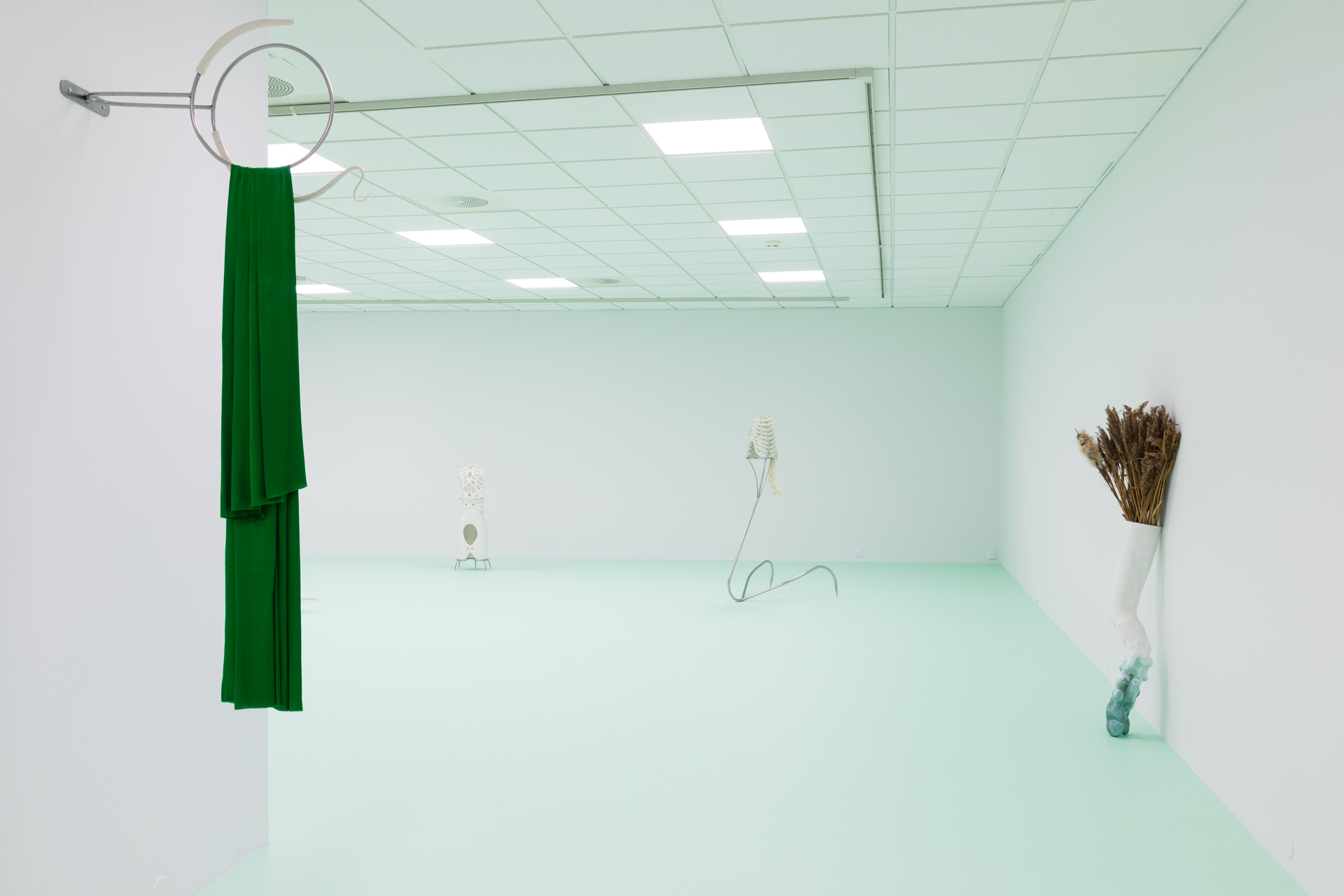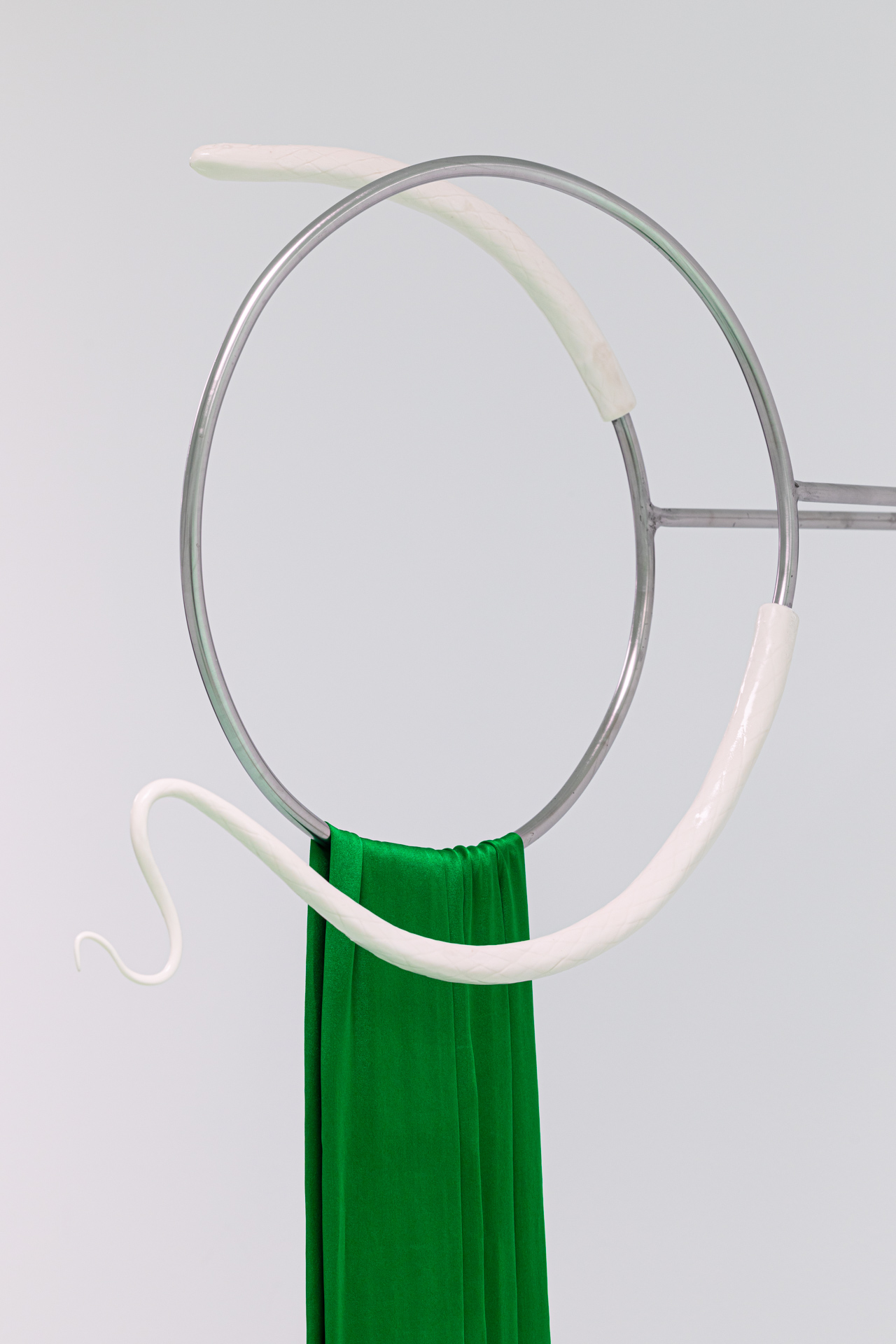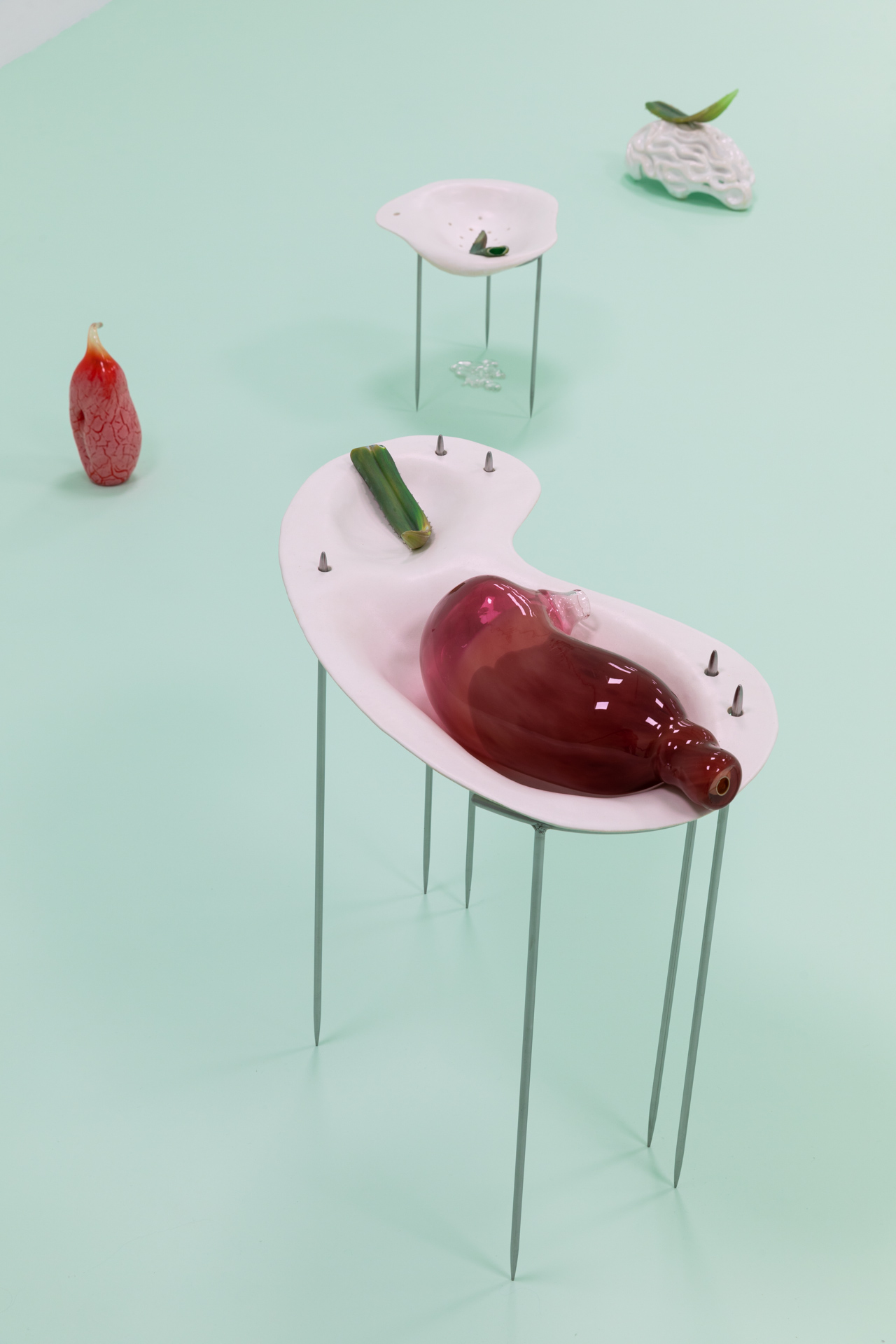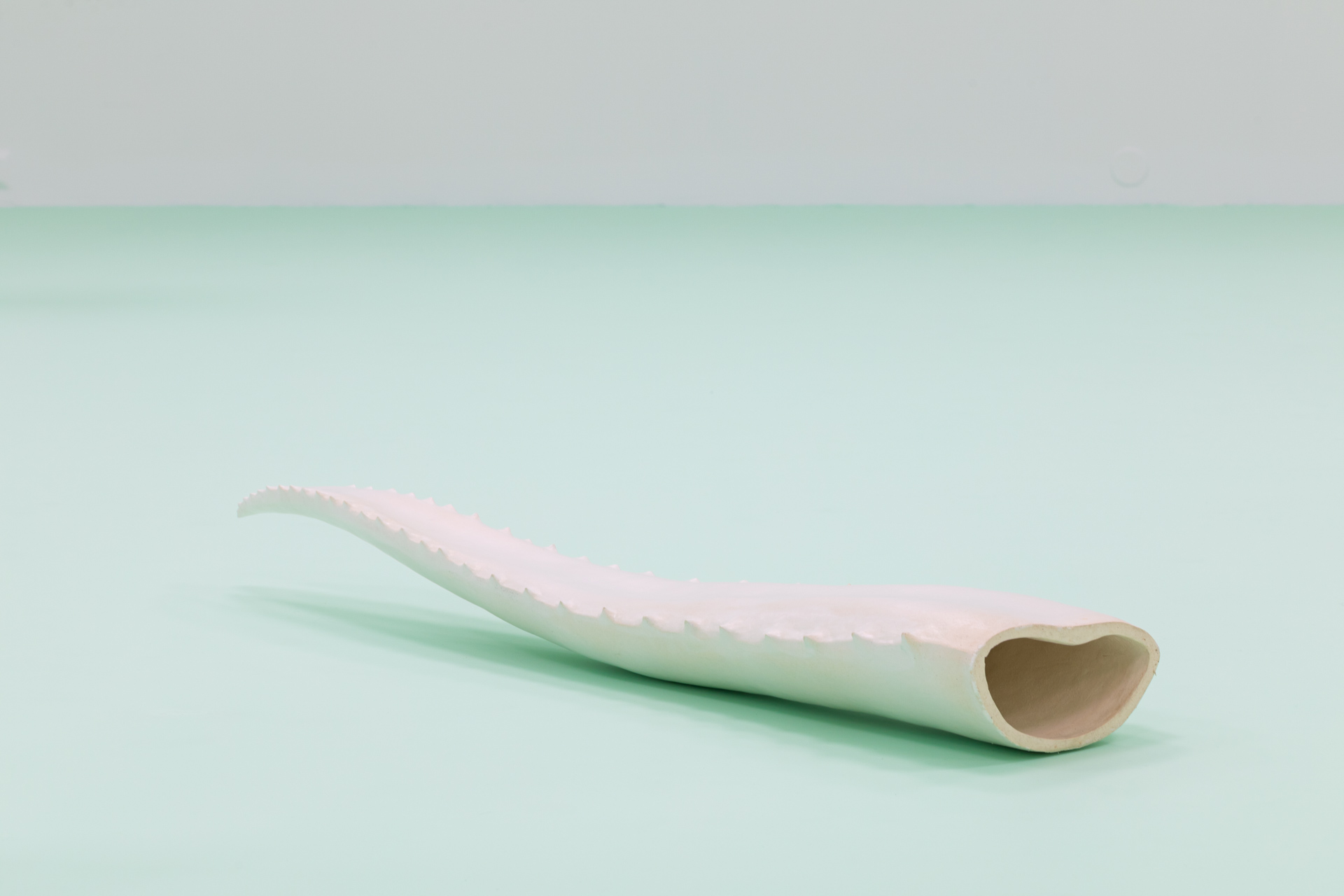Balsamarium
30. January – 4. April 2021
Nordnorsk Kunstnersenter (North Norwegian Art Centre), Svolvær
Curator: Torill Østby Haaland
Documentation: Kjell Ove Storvik
Reviews:
BALSAM FOR HELBREDELSE, ELLER DØD?, Øystein Voll, Se Kunst Magasin
Morells paradoksale univers by Ina Gravem Johansen, KUNST
Linda Morell: Balsamarium from NNKS / LIAF on Vimeo.
A spine, of sorts, made of ceramics; a glistening, colourful intestine like shape made of glass; a stomach? A heart? A leg. An arm. Linda Morell’s universe is filled with objects that are reminiscent of something human, something bodily. Yet, it is as if the human is disturbingly absent. The organ like objects lay scattered, amputated. Some of them seem to be morphing into something else entirely, and gaining new functionality. Several of them are placed on small tables that evoke associations to something from an operating room, but with submerged bowl like table tops, as if their purpose is to collect the fluids from something that is leaking. The bodies in this room are synthetic and deconstructed. They might resemble prostheses, anatomical models, or parts for a robot. So, who is it meant for, the healing fluid that runs from the cut aloe vera leaves? Who is the intended user of the draped textile that hangs on a rack on the wall? Are the dried plants in the large leg shaped urn, placed against the wall, meant to provide a relaxing atmosphere for someone? If so, what is the meaning of the sharp metal that conjures such painful associations? The sculptures relate to the human body and suggest something healing and caring, while also brutally repelling us.
The brushed steel, the glass and the glazed ceramic surfaces glisten. We have all become used to the clinical and the clean over the past year. Surfaces are continuously being disinfected. Avoiding contamination has become a part of every day life; like a reflex. Morell takes her inspiration from a past long before the covid pandemic. The health temples of ancient Greece, where science and spirituality went hand in hand, has been her staring point for investigating our current relationship to the body and to health. And just as much as glistening, spotless surfaces Morells works deals with what is inside. With the body, with containers, and with the body as a container.
Humourism has its origin in the Greek nature philosophers, and their idea that everything has its origin in the four basic elements of fire, earth, air and water. In the human body, the four elements were represented by the liver, the spleen, the heart and the brain, and the theory was that these four organs in turn discharged the liquids yellow bile, black bile, blood and slime. The idea was that these liquids had to be in balance in order for Man to maintain good health. Too much or lack of one of them tantamount to illness. The body was like a vessel for these four elements, where the landscape within alternated between suffering from drought, cold, heat and moistness. A thing of the past, one might think. Yet Morell has studied how elements from these ancient ideas about the body has lived on alongside modern medical science, and how they intertwine with it in order to create new myths of the optimized body.
“Such as the food is, such is the blood: and such as the blood is, such is the flesh,” wrote Thomas Coghan in the book The Haven of Health in 1584. At this time, humourism permeated medicine. Yet even today, the saying “you are what you eat” is a fairly uncontroversial one. As of the 2000s, detox became a common practice in order to cleanse ones body of inner poisons. The human body was yet again a vessel; an object with vague functions that one attempted to gain control over, shape and construct. The pandemic that hit us on a global scale in 2020 has again proved how inaccessible bodily functions can be to us. In spite of medical research on a grand scale, there is still a lot we do not know. We do not always know who is infected, how sick we may get, nor if or how we regain full health. The ambiguity in Morell’s objects can be read as a timeless expression for the inaccessible and the uncertainties related to the body and its functions.
– Torill Østby Haaland
The brushed steel, the glass and the glazed ceramic surfaces glisten. We have all become used to the clinical and the clean over the past year. Surfaces are continuously being disinfected. Avoiding contamination has become a part of every day life; like a reflex. Morell takes her inspiration from a past long before the covid pandemic. The health temples of ancient Greece, where science and spirituality went hand in hand, has been her staring point for investigating our current relationship to the body and to health. And just as much as glistening, spotless surfaces Morells works deals with what is inside. With the body, with containers, and with the body as a container.
Humourism has its origin in the Greek nature philosophers, and their idea that everything has its origin in the four basic elements of fire, earth, air and water. In the human body, the four elements were represented by the liver, the spleen, the heart and the brain, and the theory was that these four organs in turn discharged the liquids yellow bile, black bile, blood and slime. The idea was that these liquids had to be in balance in order for Man to maintain good health. Too much or lack of one of them tantamount to illness. The body was like a vessel for these four elements, where the landscape within alternated between suffering from drought, cold, heat and moistness. A thing of the past, one might think. Yet Morell has studied how elements from these ancient ideas about the body has lived on alongside modern medical science, and how they intertwine with it in order to create new myths of the optimized body.
“Such as the food is, such is the blood: and such as the blood is, such is the flesh,” wrote Thomas Coghan in the book The Haven of Health in 1584. At this time, humourism permeated medicine. Yet even today, the saying “you are what you eat” is a fairly uncontroversial one. As of the 2000s, detox became a common practice in order to cleanse ones body of inner poisons. The human body was yet again a vessel; an object with vague functions that one attempted to gain control over, shape and construct. The pandemic that hit us on a global scale in 2020 has again proved how inaccessible bodily functions can be to us. In spite of medical research on a grand scale, there is still a lot we do not know. We do not always know who is infected, how sick we may get, nor if or how we regain full health. The ambiguity in Morell’s objects can be read as a timeless expression for the inaccessible and the uncertainties related to the body and its functions.
– Torill Østby Haaland
































